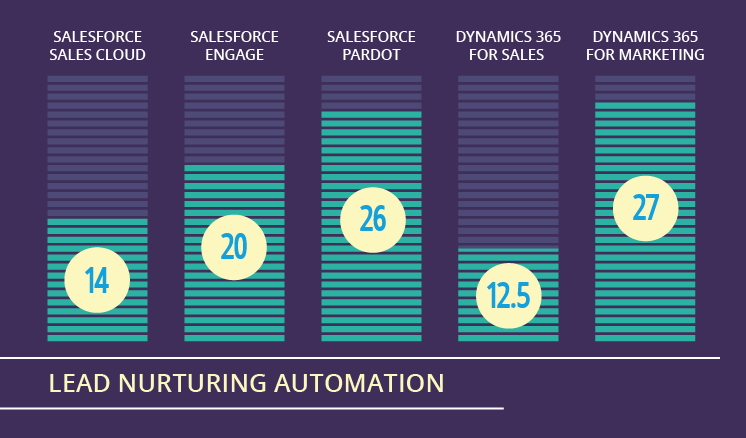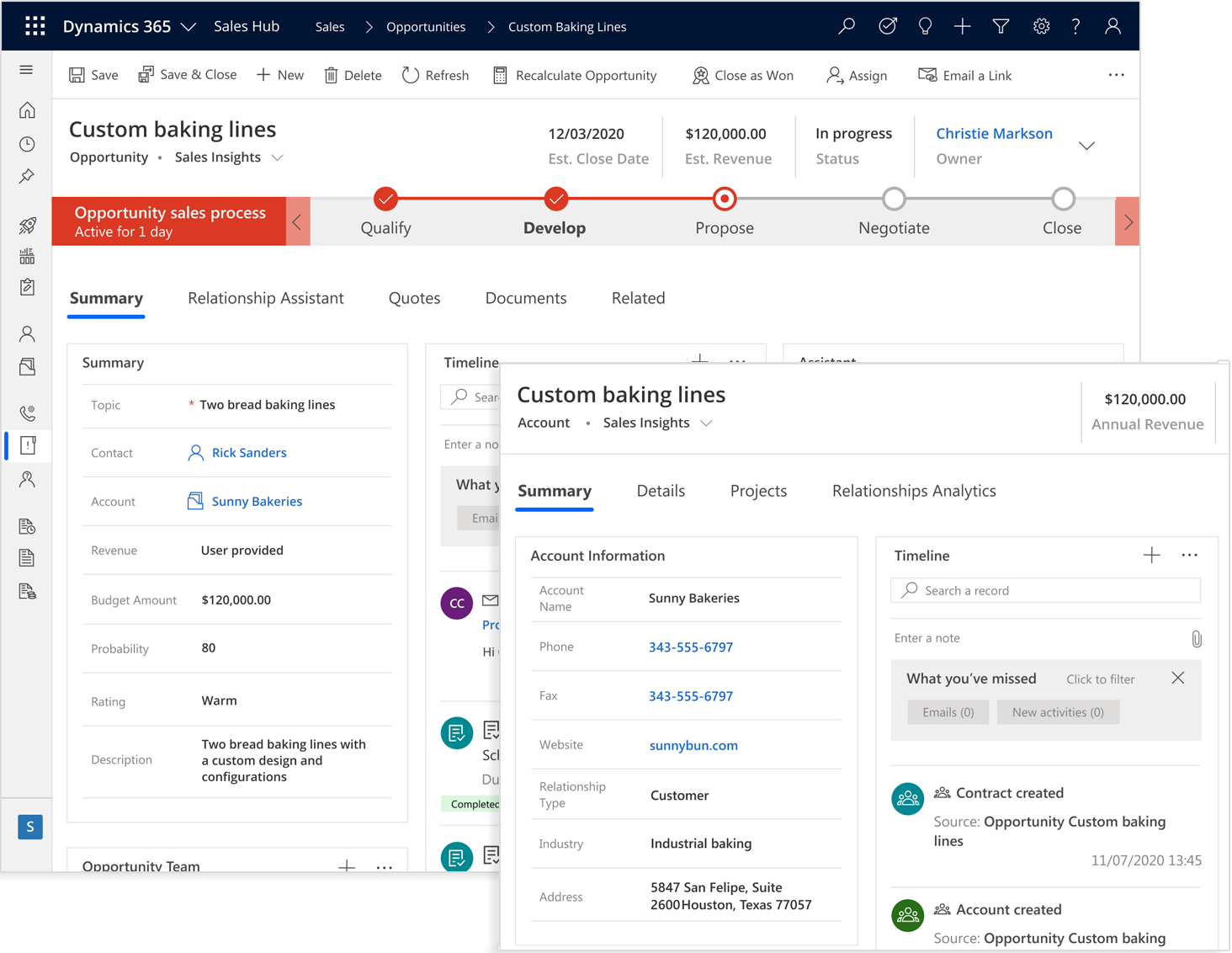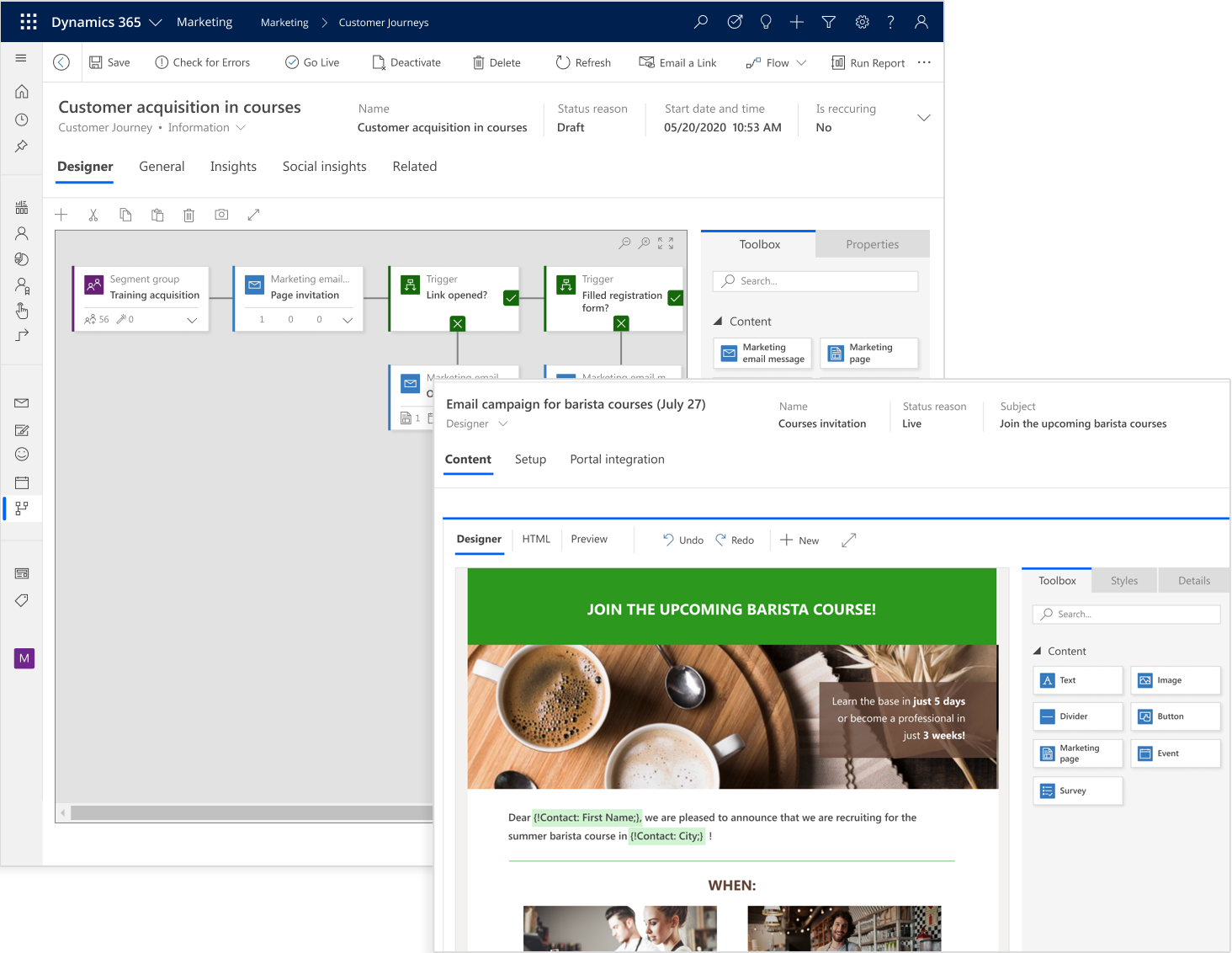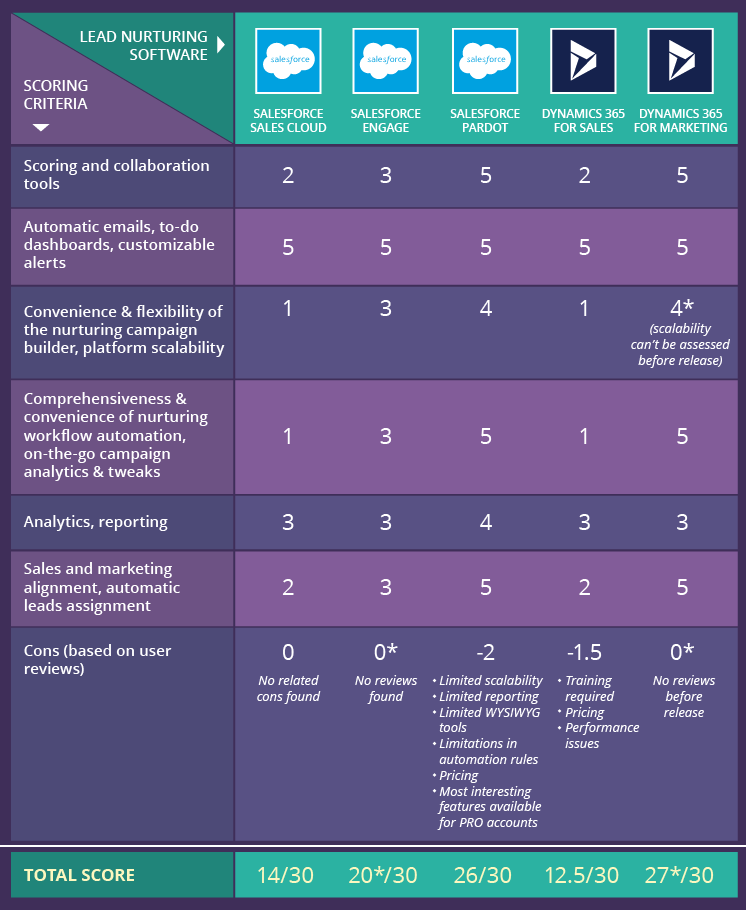Microsoft Dynamics 365 vs. Salesforce – Which one is best for lead nurturing?
Leads postpone their purchases, pause communication to consider other vendors or fail to advance for any other reason? This doesn’t mean you lost these leads. They are just not ready to buy yet. And you can still return them to the sales pipeline with continued nurturing.
In fact, Forrester states that companies excelling at lead nurturing generate 50% more sales-ready leads at 33% lower cost. As no sales rep can sacrifice the time required for interaction with stronger leads, CRM software should be equipped with functions that automate the lead nurturing process. We chose two leading CRM platforms, Salesforce and Microsoft Dynamics 365, to explore their drip marketing features. Read on to find out the winner.
Scoring criteria
Based on our experience in Dynamics 365/CRM and Salesforce, we split the lead nurturing process into 6 steps and used them as a basis for scoring. Platforms get points according to completeness and convenience of their functionality at every step.
- Monitor leads’ quality. A company needs prequalification to prioritize leads and plan nurturing efforts. After the executives have defined lead qualification criteria, CRM software can streamline the process with automatic lead scoring, instant in-app approval and collaboration tools for sales and marketing teams.
Features in focus: scoring and collaboration tools - 5 points max.
- Respond instantly. As timing is key for online communication, lead nurturing functionality should include automatic email responses as well as reminders to sales reps to contact within stated time frame.
Features in focus: automatic emails, to-do dashboards, customizable alerts - 5 points max.
- Get personal to provide value. To build trust, a company has to provide their leads with a highly personalized experience. This implies creating multiple lead nurturing tracks for specific segments. When the number of customer segments goes up, the convenience of filters used for adjusting lead nurturing workflows matters a lot.
Features in focus: convenience and flexibility of the nurturing campaign builder, platform scalability - 5 points max.
- Stay actively in touch. Being careful to leads’ activities (clicks to links, email openings, browsing history) allows sales reps to better understand what leads seek and timely give it. Here, CRM software can assist with automated tracking of customer interactions followed by suggestions of content and changes in the nurturing plan. Long-term nurturing also requires an automatic delivery of emails according to a predefined schedule.
Features in focus: comprehensiveness and convenience of nurturing workflow automation, on-the-go campaign analytics and tweaks - 5 points max.
- Analyze interactions to win more leads. Analyzing success stories, a company generates lead nurturing best practices. This analysis also helps to identify content, communication channels and even activity time frames that have greater effect on the conversion rate.
Features in focus: analytics, reporting - 5 points max.
- Align marketing and sales efforts. Depending on a company’s business processes, reengaging cold leads or nurturing new ones can be on the plate of either marketing or sales team. A lead nurturing solution should be flexible enough to allow collaboration between sales and marketing departments at as many nurturing stages as a company needs.
Features in focus: sales and marketing alignment, automatic leads assignment - 5 points max.
Total score: 30 points.

Salesforce
The spectrum of Salesforce products includes 3 solutions suitable for nurturing leads. We are talking about Sales Cloud, Salesforce Engage, and Salesforce Pardot.
1. Sales Cloud
If lead nurturing rests entirely on the sales team’s shoulders, Sales Cloud, CRM software at its core, can be enough. Sales Cloud allows sales reps to:
- Use workflows to create and manage nurturing campaigns (not as convenient as in Pardot).
- Use marketing email templates.
- Set up notifications to monitor campaign results.
- Follow a visualized lead path to recap nurturing details quickly.
- Always stay tuned with Salesforce1 mobile app, as well as integrated real-time news and twitter feeds.
Pricing: starting $75 per user per month.
Total score: 14/30.
Resume: Sales Cloud as a lead nurturing tool can be enough for companies that entrust reengaging a limited number of cold leads to their sales reps. In this case, the marketing team provides valuable engagement content and generates raw leads.
2. Salesforce Engage
Salesforce Engage is a marketing and sales alignment solution powered by Pardot. It works on top of Sales Cloud and extends its lead nurturing functionality with more specific features and convenient navigation. Salesforce Engage helps sales reps to:
- Launch and manage lead nurturing campaigns.
- Use marketing-approved assets.
- Set up alerts on leads activities.
- Work on-the-go in a mobile version.
- Track campaign progress via reports.
Pricing: $50 per user per month for up to 10,000 contacts (in addition to the Sales Cloud license).
Total score: 20*/30.
*The total score doesn't include user reviews.
Resume: Salesforce Engage equips sales reps with strong marketing automation functionality and provides direct access to marketing assets they need to win more leads. Salesforce Engage is a fine solution for sharing lead nurturing responsibility between sales and marketing.
3. Salesforce Pardot
Pardot was a leading marketing automation solution even before Salesforce acquired it. Pardot offers strong capabilities for nurturing raw leads, as well as for reengaging cold or postponed ones. Native integration with Salesforce ensures a quick and secure data sync with the CRM. Drilling down to lead nurturing features, Pardot is a mature assistant for both marketers and sales people.
- Lead quality control is based on:
- Enhanced understanding of the buying intent and readiness. For this, Pardot tracks interactions with the website content and figures out firmographics if the visitor is anonymous.
- Using flexible grading and scoring models that help to prioritize leads automatically. Prioritization can be based either on changing interest in the offering or on a fit between a lead’s characteristics and the ideal lead profile.
- Instant communication kick-off rests on customizable alerts and a very convenient builder of automated greeting emails. The builder also allows A/B testing of alternative templates and email rendering to check how the content looks in top email clients, browsers and on mobile devices.
- Personal touch is added using a flexible nurturing campaign builder that supports dynamic content, tags, rules and triggers. Test drives of visual campaigns help to avoid pitfalls in the nurturing process. With too many segments to target, choosing assets and activities options can become quite complicated. In this regard, enterprises with more than 5,000 employees name limited scalability of Pardot as one of its cons.
- Long-term lead nurturing is simplified with a convenient campaign builder, automatic tracking of leads’ activities followed by updates of profiles and sales-readiness scores.
- Polishing of lead nurturing campaigns follows the analysis of click-through rates, email openings and review of overall campaign performance indicators.
- Sales and marketing alignment is achieved thanks to:
- Automation rules for leads assignment that regulate the flows of warmed-up leads from marketers to sales reps.
- A highly collaborative environment of the Salesforce platform based on feeds and tags, and shared assets that allows marketers and sales teams to deliver a consistent message.
Pricing: starting $1,000 per month per up to 10,000 contacts. The most interesting features, like A/B testing of emails, AdWords integration, dynamic email content, custom event-based reporting and multiple scoring criteria, are available only for PRO accounts.
Total score: 26/30.
Resume: Salesforce Pardot is a recommended option for establishing large-scale lead nurturing campaigns when both marketing and sales departments actively contribute to lead nurturing.
Microsoft Dynamics 365
Microsoft provides lead nurturing features in Dynamics 365 for Sales and Dynamics 365 for Marketing.
1. Dynamics 365 Sales
Dynamics 365 Sales is a CRM solution by Microsoft. As in Salesforce Sales Cloud, the in-built lead nurturing capabilities of Microsoft CRM are quite limited and include:
- Quick (not editable) and detailed marketing campaigns.
- Association of products and marketing assets with campaigns.
- Lead progress bar.
- Customizable notifications.
- Workflow automation with processes builder.
- Campaign progress tracking.
Pricing: $95 per user per month.
Total score: 12.5/30.
Resume: in-CRM lead nurturing will work for long-term engagement or reengagement campaigns targeted at a limited number of the most valuable leads.

Watch an Interactive Dynamics 365 Sales Demo
2. Dynamics 365 Marketing
Microsoft discontinued Microsoft Dynamics Marketing, their solution for marketing automation, in May 2018. A new online service, Dynamics 365 Marketing, entered the market instead.
Dynamics 365 Marketing also reflects the company’s ‘less coding, more configuration’ approach, so the app navigation will become much more convenient. Features required for lead nurturing will mostly remain the same as in Dynamics Marketing with a few enhancements, like incorporated Customer Insights module and channels extended with LinkedIn and webinars.
Down to lead nurturing step-to-feature analysis, Dynamics 365 Marketing comprises:
- Flexible lead scoring and prioritization models that bring together firmographics, custom grades, and rules to automatically identify sales readiness based on how leads respond to emails and events.
- Drag-and-drop builder of email templates, forms and landing pages with the asset preview feature.
- On-the-go insights into email and landing page performance that help to identify leads’ needs and better personalize nurturing campaigns.
- Strong event management functionality, including event portal, and hosting of webinars.
- Drag-and-drop customer journey designer to orchestrate multi-channel campaigns and quickly visualize lead nurturing cycle.
- Configurable dashboards, analytics and reporting to analyze nurturing campaign results, identify best-performing lead sources and marketing activities. Note: while some reports are accessible in Dynamics 365 Marketing directly, others will require incorporation of separately charged:
- Power BI (for measuring marketing effort in terms of conversion, volume and velocity)
- Customer Insights (analysis of lead quality, relationship health and effectiveness of lead scoring models).
- Automated lead assignment. Dynamics Marketing supported a highly customizable yet tricky distribution of leads. So far, there is no information about the feature in Dynamics 365 Marketing. However, the overall orientation to a more convenient UI looks promising.
- Sales Collaboration Panel. This very handy tool for sales and marketing alignment will remain in the spring release. It allows sales reps to grasp leads’ engagement with marketing activities, explore campaigns that their assigned leads went through, and create alerts tight to leads activities.
Pricing: starting $1,500 per month for 10,000 contacts. It will be charged separately from Dynamics 365 Sales.
Total score: 27*/30.
*The total score doesn't include user reviews.
Resume: Dynamics 365 Marketing will suit considerable lead nurturing needs. For large enterprise customers, Microsoft recommends their partner’s solution - Adobe Marketing Cloud.

Watch Dynamics 365 Marketing Demo
So, the choice is…
Let’s summarize the strengths and weaknesses of these lead nurturing tools.

Offerings by both Salesforce and Microsoft can suit different lead nurturing needs. The final choice depends on the required amount of leads to manage and responsibilities of marketers and sales reps in a company. To take a better-informed platform decision, feel free to contact our CRM consultants.

